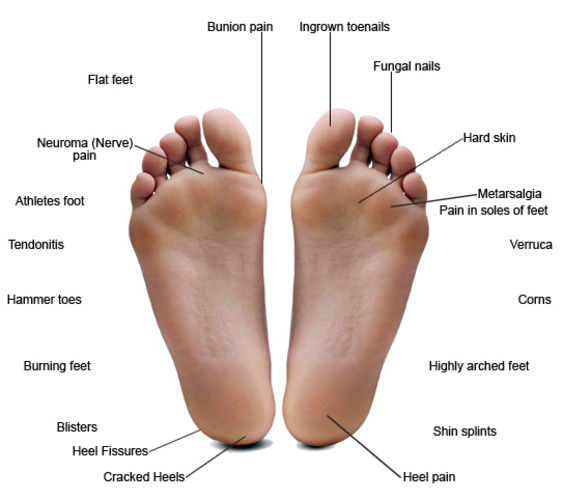Foot Conditions.

Some of the foot conditions which can be helped by Custom Foot Orthotics
Lower Back Pain: Lower back pain typically manifests as aching, soreness, and tightness in the lower spine and surrounding muscles. These symptoms often occur during activities such as standing, walking, or running. A common but often undiagnosed cause of lower back pain is having flat feet or high arches. Solution: In the short term, a Vancouver chiropractor can treat the symptoms of lower back pain with chiropractic adjustments. For a long-term solution, addressing the underlying cause with foot orthotics is recommended.
Piriformis Syndrome: This condition involves lower back pain that originates from the buttock or gluteal muscles and radiates to the lower spine or thighs. It causes pain around the lower spine and muscles of the lower back. Common causes include flat feet or high arches, which create an imbalance in the lower body, leading to irritation of the sciatic nerve and excessive pronation or supination of the feet. Solution: Custom foot orthotics can help correct and balance the arch height, addressing the underlying issue.
Iliotibial Band Syndrome (ITB): The iliotibial band is a fascia that connects the patella (kneecap) to the outside of the pelvic bones. Symptoms: Pain on the side of the thighs near the knees, sometimes around the kneecap or on the outsides of one or both knees. Running downhill can exacerbate this condition. Causes: Overpronation, oversupination, and flat feet. Solution: Correcting the faulty biomechanics of the foot using custom foot inserts.
Patellofemoral Syndrome (PFPS): Patellofemoral Pain Syndrome (PFPS) describes pain at the front of the knee originating from the patella (kneecap).Causes: Flat feet or high arches cause rotation of the leg bone, which stresses the knee and the ligaments holding the knee joint together. Solution: Correcting flat feet or high arches and the resulting pronation or supination with foot orthotics.
Chondromalacia Patella (Runner’s Knee): Chondromalacia patella is the softening and breakdown of the cartilage that lines the underside of the kneecap (patella). It is a common cause of anterior knee pain, more frequently occurring in females. This condition can be related to the abnormal positioning of the knee. The kneecap (patella) sits over the front of the knee joint, and as you bend or straighten your knee, the underside of the patella glides over the bones that make up the knee. Custom foot insoles are used for correcting and treating this condition.
Shin Splints: Shin splints, also known as medial tibial stress syndrome, are a common condition characterized by pain along the shinbone (tibia), the large bone in the front of the lower leg. Shin splints often occur in athletes and individuals who engage in activities involving repetitive stress on the legs, such as running, dancing, or jumping. Custom foot orthotics can help alleviate this condition.
Achilles Tendonitis: This condition involves pain and inflammation at the back of the heel, specifically in the bursa between the Achilles tendon and the heel bone. Symptoms include pain and tightness at the back of the heel where the Achilles tendon attaches to the bone. Custom foot insoles can help alleviate this condition.
Plantar Fasciitis: Plantar fasciitis is one of the most common causes of heel and foot pain. It occurs when the plantar fascia, a band of tissue under the foot and arch, becomes inflamed, causing heel pain that may radiate into the foot. The pain can be sharp at times and is typically worse first thing in the morning but may ease off and then gradually worsen later in the day. Custom foot orthotics can help alleviate this condition.
Bunions: Bunions are a common foot condition that affects the joint at the base of the big toe. They occur when the bone or tissue at the joint becomes misaligned, causing the big toe to point inward toward the other toes. This misalignment can lead to a bony bump on the side of the foot, which is characteristic of bunions. Custom foot inserts can help with this foot condition.
Heel Spurs: Heel pain caused by a heel spurs is similar to plantar fasciitis. A heel spur is a calcification of the tendon and a growth inside the heel where the plantar fascia attaches. Symptoms are similar to plantar fasciitis, but a heel spurs can be present without pain and vice versa. This pain can be sharp all day and is secondary to flat feet. Custom foot orthotics would be very helpful for this foot condition.
Morton’s Neuroma: Morton’s neuroma, also known as interdigital neuroma, is a common foot condition characterized by the thickening of the tissue around one of the nerves leading to the toes, typically between the third and fourth toes. This thickening of the nerve can cause pain, numbness, tingling, or a burning sensation in the ball of the foot or between the toes. Morton’s neuroma often feels like there is a small pebble or marble inside the shoe. Custom insoles can help reduce the pressure on the nerves passing between the foot bones or metatarsal bones.
Calluses: Callus formation, also known as a callus, is a thickened and hardened area of skin that develops in response to repeated pressure, friction, or irritation. Calluses typically form on areas of the skin that experience repetitive rubbing or mechanical stress, such as the hands, feet, or knees. They serve as a protective mechanism to shield the skin from damage and reduce the risk of blisters or injuries in high-pressure areas. Custom foot orthotics can help correct the alignment of the foot, taking pressure away from the heel and the joint of the big toe.
Heel Pain: Heel pain is a common foot complaint that can affect people of all ages and activity levels. It can occur due to various factors and conditions, each requiring different approaches to management and treatment. Custom foot orthotics can help correct the alignment of the foot.
Metatarsalgia: Metatarsalgia is a common foot condition characterized by pain and inflammation in the ball of the foot, specifically in the area where the metatarsal bones connect to the toes. The metatarsals are the long bones in the midfoot region that form the arch of the foot and help distribute weight during walking, running, and standing. Metatarsalgia can affect one or more metatarsal heads (the rounded ends of the metatarsal bones) and is often associated with activities that involve high-impact or repetitive pressure on the feet. Custom foot orthotics can help correct the alignment of the foot.
Flat Feet/Low Arches/Pes Planus: Flat feet, also known as fallen arches or pes planus, is a common foot condition where the arches of the feet are lower than normal or completely flattened, causing the entire sole of the foot to come into contact with the ground. This can result in altered foot mechanics, changes in gait, and potential issues with foot alignment and stability. Custom foot inserts can help correct the alignment of the foot.
High Arched Feet/Pes Cavus: High arches, also known as pes cavus or cavus foot, refer to a foot structure where the arch of the foot is unusually raised or curved, resulting in less surface area in contact with the ground during standing or walking. This condition can affect one or both feet and is characterized by a distinctively high arch appearance, where the toes and heel may appear more pronounced or elevated than usual. Foot orthotics can help correct the alignment of the foot.
Overpronation: Overpronation is a common foot condition that occurs when the foot rolls inward excessively while walking or running. This inward rolling motion causes the arch of the foot to flatten and the ankle to turn inward, leading to biomechanical imbalances and potential issues with foot alignment. Overpronation can affect people of all ages and activity levels and may contribute to various foot and lower limb problems if not properly addressed. Custom foot insoles can help correct the alignment of the foot.
Short Leg/Heel Lift: A short leg heel lift, also known as a shoe lift or heel insert, is a device used to address leg length discrepancies or differences in the length of the legs. Leg length discrepancies can occur due to various reasons, such as genetics, injuries, or developmental abnormalities. When one leg is shorter than the other, it can lead to issues with posture, gait, and musculoskeletal alignment, potentially causing discomfort or pain in the hips, back, or lower extremities. This condition requires foot orthotics with specific heel lift to correct the alignment of the foot.
At Burrard Custom Foot Orthotics, we are able to help our patients with their feet, ankles, knees, hips, and low back conditions.



